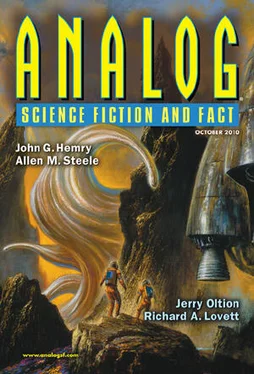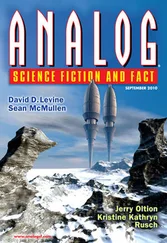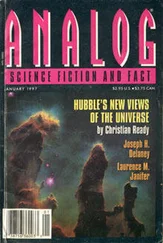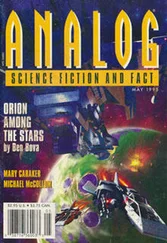Jerry Oltion - Never Saw It Coming
Здесь есть возможность читать онлайн «Jerry Oltion - Never Saw It Coming» весь текст электронной книги совершенно бесплатно (целиком полную версию без сокращений). В некоторых случаях можно слушать аудио, скачать через торрент в формате fb2 и присутствует краткое содержание. Год выпуска: 2010, Издательство: Dell Magazines, Жанр: Фантастика и фэнтези, на английском языке. Описание произведения, (предисловие) а так же отзывы посетителей доступны на портале библиотеки ЛибКат.
- Название:Never Saw It Coming
- Автор:
- Издательство:Dell Magazines
- Жанр:
- Год:2010
- ISBN:нет данных
- Рейтинг книги:3 / 5. Голосов: 1
-
Избранное:Добавить в избранное
- Отзывы:
-
Ваша оценка:
- 60
- 1
- 2
- 3
- 4
- 5
Never Saw It Coming: краткое содержание, описание и аннотация
Предлагаем к чтению аннотацию, описание, краткое содержание или предисловие (зависит от того, что написал сам автор книги «Never Saw It Coming»). Если вы не нашли необходимую информацию о книге — напишите в комментариях, мы постараемся отыскать её.
Never Saw It Coming — читать онлайн бесплатно полную книгу (весь текст) целиком
Ниже представлен текст книги, разбитый по страницам. Система сохранения места последней прочитанной страницы, позволяет с удобством читать онлайн бесплатно книгу «Never Saw It Coming», без необходимости каждый раз заново искать на чём Вы остановились. Поставьте закладку, и сможете в любой момент перейти на страницу, на которой закончили чтение.
Интервал:
Закладка:
Never Saw It Coming
by Jerry Oltion
On March 2, 2009 an asteroid the size of a football field flew past Earth close enough to scare the pants off anybody who was paying attention. If it had hit, the impact would have created a blast equivalent to the ones that destroyed Hiroshima and Nagasaki.
Amateur astronomers worldwide were disappointed. Not because they wanted to witness the impact, although a few undoubtedly did, but because the asteroid had been discovered two days before its passage, yet word hadn’t gotten out in time for anyone to set up their telescopes and look at it. Worse, they learned after the fact; the news had been deliberately suppressed so it wouldn’t cause a panic, even after the few astronomers who knew about it had calculated its orbit and confirmed it would miss the Earth.
When Craig Hendrickson learned about that, he set up the Near Earth Asteroid Reporting Database, or NEARD. People laughed at the acronym, but that didn’t bother him. As long as the right people used it—and yes, most of those people were nerds—then he would be happy.
The idea was to give amateur astronomers like himself a place to post their observations of short-notice phenomena so others could confirm their sightings and share the joy of watching a normally invisible piece of the solar system drift by close enough to see. Craig rigged up an e-mail alert system so people didn’t have to check the site every few hours, and he added a Twitter feed so people already in the field could get tweets on their cell phones to notify them of new targets to observe that same night. He publicized it on the Cloudy Nights astronomy forum, and a few months later Astronomy and Sky & Telescope magazines ran short articles on it.
There were the inevitable naysayers who condemned his effort as an irresponsible act sure to ignite a global panic the first time someone posted an unchecked observation, but Craig countered them by putting a prominent notice on the front page of the NEARD web site: “The observations reported on this site are preliminary, and speculation on any object’s path is just that—speculation—until confirmed by several independent observers.” That was too many characters for a tweet, so he shortened it to simply “Spec Alert” in the Twitter announcement.
Near Earth asteroids are relatively rare. Craig didn’t expect the system to be used more than once or twice a year, if that. For the first year it was pretty much as he’d expected: two posts, one for an object that turned out to be a known comet and one for something nobody else, not even the person who reported it, could find again. So Craig was surprised when he discovered his own asteroid just a few months into the second year while searching for the last remnant of Comet Murray as it dropped toward the Sun.
It wasn’t as much a coincidence as it might have been. With the economy in the toilet for the third straight year—now officially a depression—Craig’s job had evaporated along with most of the country’s wealth. He was “between girlfriends” in pretty much the same way he’d been “between jobs” for the last eight months or so. He had plenty of time to spend outdoors with his telescope, and no worries about keeping anybody up at home or having to get up early himself for work. Even better: he had discovered that time spent under the stars was time not spent worrying about his future. The joy of simply looking at the cosmos overrode all other concerns. So he spent hours simply scanning the sky with his telescope, and he had become pretty good at recognizing what he saw.
It was a warm night in early May, one of the first shirtsleeve nights of the season. Craig was in his driveway, cursing the neighbor’s porch light as he always did when he set up his scope at home. He hadn’t intended this to be a major night out, since the Moon was coming up in an hour and a half, so he hadn’t bothered to go to any of his more dark-friendly sites. Just a quick look before the Moon rose and ruined the sky even worse than the city lights. He hadn’t even gotten out his big telescope. He was using his six-inch Dobsonian, the one he called the “yard cannon” because it was just about the size of a portable artillery piece and you aimed it pretty much the same way.
Taurus and Orion had already set. Craig was hunting around near M35, the open cluster at the right foot of Gemini, for the comet when he found a relatively bright star that wasn’t on his finder chart. At first he didn’t think much of it, since M35 was full of stars; then he began comparing this one to what was on the chart and realized that the unknown star was at least a magnitude brighter than the chart’s lower limit. It should have been listed.
He checked its position carefully against the surrounding stars and drew it in on his chart. Then he went inside and posted it on the NEARD web site. His tweet simply said, “Found new object in M35. What is it?”
It takes three observations spaced out over time to calculate an orbit. The NEARD alert ensured plenty of observations, but there wasn’t much anybody could do for time, especially since the object was barely moving against the stellar background. That meant it would be several days before it moved enough to get even a rough idea of its path through the solar system.
That didn’t stop people from speculating. One possible explanation for its slow apparent motion was that it was coming straight at Earth, and since that was clearly the most exciting possibility, that’s the one people latched onto. The internet was soon abuzz with doomsday descriptions of how bad the damage would be when it hit. Apparently it gave people something besides the depression to worry about.
And Craig Hendrickson’s name was on the original post. Worse, his “Spec Alert” notice at the head of the Twitter announcement had been misunderstood as “Special Alert,” which added yet more artificial urgency to the whole business. He found himself inundated with emails and phone calls from journalists all over the world, all with the same question: How long do we have to live?
“Look,” he told them, “we don’t know where it’s headed. It could be moving away from us. But even if it’s not, the odds of it hitting Earth are almost zero.”
On the news feeds, that translated to: “Discoverer unsure where it will hit!” Craig’s phone began ringing practically nonstop after that, and his email inbox filled up faster than he could read it.
He spot-checked what he could. At least half of it was forwards of his original NEARD announcement, the disclaimer conveniently snipped off, with several added posts building toward the inevitable “WE’RE ALL GONNA DIE!!!”
Late on the third night after he’d made his discovery, Craig stared at his inbox, watching the “percent full” bar inch upward pixel by pixel. His cell phone added its low-battery warning to the incessant ring.
He navigated to the NEARD site, opened up a text window, and wrote, “YOU’RE ALL A BUNCH OF IDIOTS.” Then he deleted that, took a deep breath, and began writing a reassuring post, explaining how unlikely an asteroid strike really was and how the fact that there was any apparent motion at all meant that this one was definitely not aimed at the Earth. “Close, maybe,” he wrote, “but close only counts in horseshoes. There is absolutely no chance that this thing will hit us.”
He imagined all the nit-pickers out there who would pounce on that statement, so he amended it to read “…absolutely no chance that this thing will hit us on this pass. It will glide around the Sun, just like it’s probably been doing for millions of years, and it will head back into the outer solar system. By the time it crosses Earth’s orbit again we’ll have its trajectory figured down to the gnat’s whisker, and if it comes anywhere close to Earth on the way out, I’ll eat my telescope.”
Читать дальшеИнтервал:
Закладка:
Похожие книги на «Never Saw It Coming»
Представляем Вашему вниманию похожие книги на «Never Saw It Coming» списком для выбора. Мы отобрали схожую по названию и смыслу литературу в надежде предоставить читателям больше вариантов отыскать новые, интересные, ещё непрочитанные произведения.
Обсуждение, отзывы о книге «Never Saw It Coming» и просто собственные мнения читателей. Оставьте ваши комментарии, напишите, что Вы думаете о произведении, его смысле или главных героях. Укажите что конкретно понравилось, а что нет, и почему Вы так считаете.












